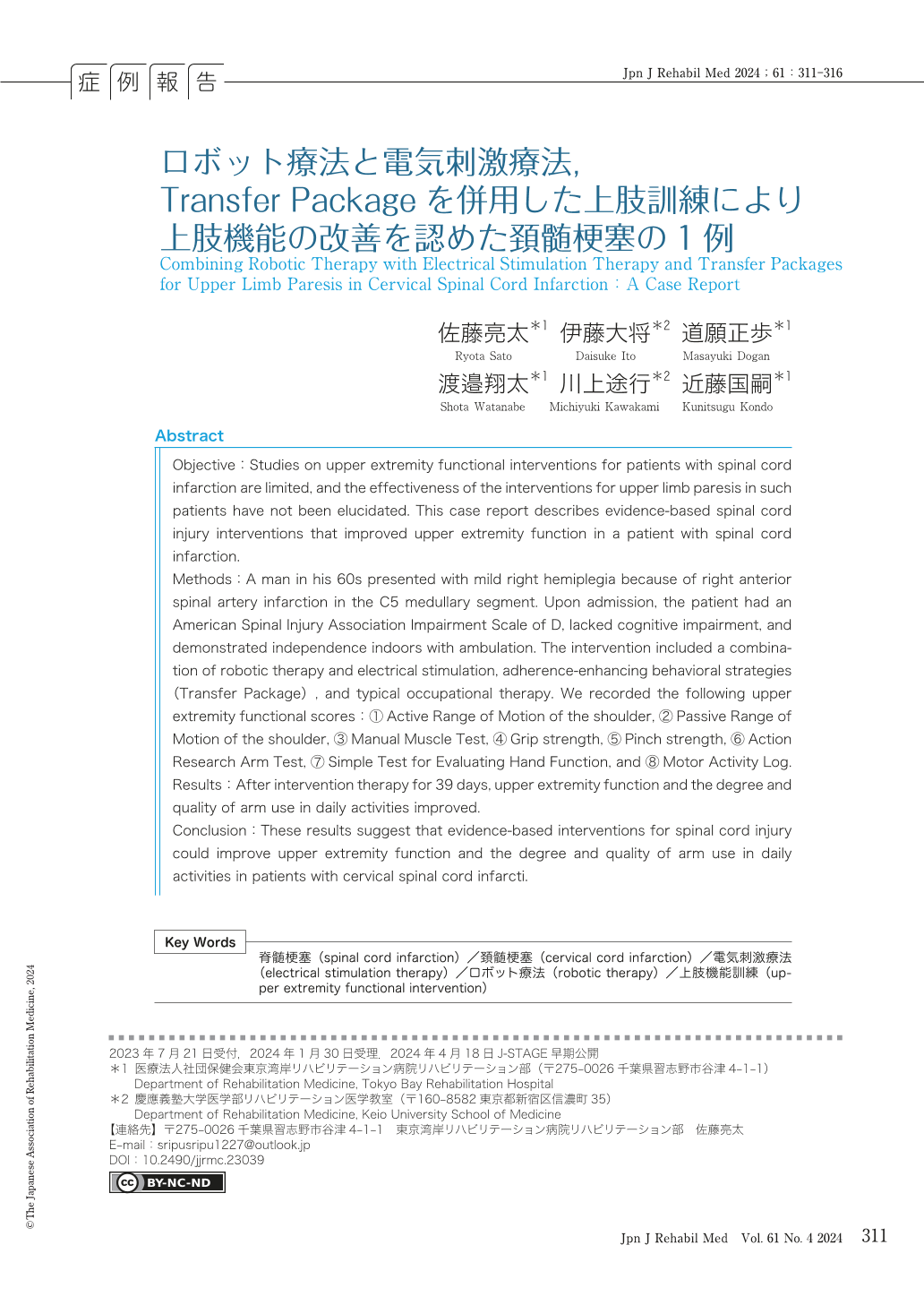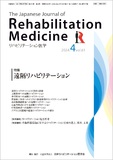Japanese
English
- 販売していません
- Abstract 文献概要
- 1ページ目 Look Inside
- 参考文献 Reference
要旨 はじめに
脊髄梗塞は,脊柱管外部動脈の虚血を原因として背部痛や四肢の筋力低下,感覚消失といった神経機能障害を生じる脊髄疾患である.脊髄梗塞の年間発生率は100万人あたり30.1人1)であり,代表的な脊髄疾患である脊髄損傷の年間発生率100万人あたり8〜246人2)と比較すると,脊髄梗塞は発生率の低い脊髄疾患であるといえる.また,脊髄梗塞の損傷髄節は胸髄レベルが最多であると報告されている3).以上より,頚髄レベルでの脊髄梗塞(以下,頚髄梗塞)の発生率はまれであるといえる.頚髄梗塞では,頚髄レベルの脊髄損傷(以下,頚髄損傷)と同様に,髄節性の運動麻痺を呈する.しかし,その発生率の低さから,頚髄梗塞の治療報告は少ない.頚髄梗塞の診断や臨床症状に関する症例報告は存在するが4, 5),リハビリテーション治療に焦点を当てた報告はなく,上肢治療に関する報告もない.
一方で,不全頚髄損傷に対する上肢訓練の報告は多数存在しており,システマティックレビューではロボット療法6),電気刺激療法6, 7),反復経頭蓋磁気刺激療法4)などの有用性が報告されている.近年では,ロボット療法と電気刺激療法の併用による相乗効果や8),脳卒中の上肢治療においてエビデンスが確立されているConstraint-Induced Therapyの効果が報告されている9, 10).不全頚髄損傷と頚髄梗塞とでは原因や症状が異なるが,神経機能障害を生じる脊髄疾患であるという点は共通している.そのため,頚髄損傷に対する有効な治療は,頚髄梗塞にとっても有益な効果を示す可能性が考えられた.
今回,C5右前脊髄動脈梗塞により軽度右片麻痺を呈した症例に対し,不全頚髄損傷に対する上肢治療のエビデンスに準じて,ロボット療法と電気刺激療法,Transfer Package(TP)の併用訓練を実施した.その結果,上肢機能の改善と,日常生活での麻痺手の使用頻度の増加を認めた.頚髄梗塞に対する上肢治療の一助として本症例を報告する.なお,本報告に関して,患者本人に説明のうえ書面にて同意を得ている.
Abstract Objective:Studies on upper extremity functional interventions for patients with spinal cord infarction are limited, and the effectiveness of the interventions for upper limb paresis in such patients have not been elucidated. This case report describes evidence-based spinal cord injury interventions that improved upper extremity function in a patient with spinal cord infarction.
Methods:A man in his 60s presented with mild right hemiplegia because of right anterior spinal artery infarction in the C5 medullary segment. Upon admission, the patient had an American Spinal Injury Association Impairment Scale of D, lacked cognitive impairment, and demonstrated independence indoors with ambulation. The intervention included a combination of robotic therapy and electrical stimulation, adherence-enhancing behavioral strategies (Transfer Package), and typical occupational therapy. We recorded the following upper extremity functional scores:①Active Range of Motion of the shoulder, ②Passive Range of Motion of the shoulder, ③Manual Muscle Test, ④Grip strength, ⑤Pinch strength, ⑥Action Research Arm Test, ⑦Simple Test for Evaluating Hand Function, and ⑧Motor Activity Log.
Results:After intervention therapy for 39 days, upper extremity function and the degree and quality of arm use in daily activities improved.
Conclusion:These results suggest that evidence-based interventions for spinal cord injury could improve upper extremity function and the degree and quality of arm use in daily activities in patients with cervical spinal cord infarcti.

Copyright © 2024, The Japanese Association of Rehabilitation Medicine. All rights reserved.


